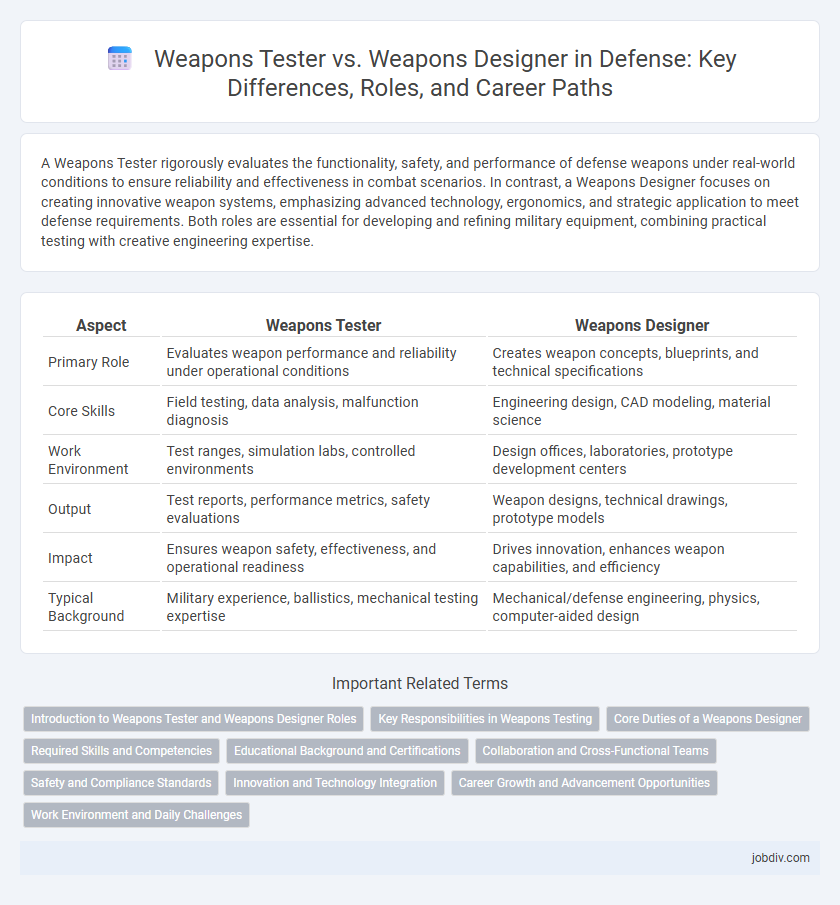A Weapons Tester rigorously evaluates the functionality, safety, and performance of defense weapons under real-world conditions to ensure reliability and effectiveness in combat scenarios. In contrast, a Weapons Designer focuses on creating innovative weapon systems, emphasizing advanced technology, ergonomics, and strategic application to meet defense requirements. Both roles are essential for developing and refining military equipment, combining practical testing with creative engineering expertise.
Table of Comparison
| Aspect | Weapons Tester | Weapons Designer |
|---|---|---|
| Primary Role | Evaluates weapon performance and reliability under operational conditions | Creates weapon concepts, blueprints, and technical specifications |
| Core Skills | Field testing, data analysis, malfunction diagnosis | Engineering design, CAD modeling, material science |
| Work Environment | Test ranges, simulation labs, controlled environments | Design offices, laboratories, prototype development centers |
| Output | Test reports, performance metrics, safety evaluations | Weapon designs, technical drawings, prototype models |
| Impact | Ensures weapon safety, effectiveness, and operational readiness | Drives innovation, enhances weapon capabilities, and efficiency |
| Typical Background | Military experience, ballistics, mechanical testing expertise | Mechanical/defense engineering, physics, computer-aided design |
Introduction to Weapons Tester and Weapons Designer Roles
Weapons Testers rigorously evaluate the performance, reliability, and safety of military armaments under varied operational conditions to ensure compliance with defense standards. Weapons Designers apply advanced engineering principles and innovative technologies to develop new weapon systems, focusing on functionality, durability, and tactical effectiveness. Both roles require deep expertise in ballistics, materials science, and defense protocols to support the advancement and integrity of military capabilities.
Key Responsibilities in Weapons Testing
Weapons Testers conduct rigorous evaluations of weapon systems to ensure functionality, safety, and compliance with military standards by performing live-fire tests, environmental simulations, and performance analyses. They collect and analyze data from testing phases to identify defects, operational limits, and potential improvements, ensuring reliability under combat conditions. Their role includes documenting test outcomes, collaborating with engineers and designers, and recommending modifications to enhance weapon effectiveness and soldier safety.
Core Duties of a Weapons Designer
Weapons designers specialize in creating and developing advanced weaponry, focusing on conceptualizing innovative technologies and integrating cutting-edge materials to enhance performance, safety, and reliability. Their core duties involve conducting detailed simulations, collaborating with engineers and defense analysts, and ensuring compliance with military standards and regulations. Unlike weapons testers who evaluate functionality and field performance, designers are responsible for the initial blueprint and technical specifications that drive weapon system development.
Required Skills and Competencies
Weapons Testers require strong analytical skills, attention to detail, and proficiency in data collection and interpretation to assess weapon performance and safety under various conditions. Weapons Designers need advanced knowledge of engineering principles, creativity in problem-solving, and expertise in computer-aided design (CAD) software to develop innovative and effective weapon systems. Both roles demand a deep understanding of ballistics, materials science, and adherence to stringent defense regulations to ensure operational reliability and safety.
Educational Background and Certifications
Weapons testers typically hold degrees in mechanical engineering, aerospace engineering, or materials science to understand the technical performance and safety of armaments. Weapons designers often require advanced degrees in fields such as weapon systems engineering, ballistics, or computer-aided design, complemented by certifications in defense technology or systems integration. Certifications like Certified Defense Systems Engineer (CDSE) or Professional Engineering (PE) license can enhance credentials for both roles, emphasizing specialized skills in weapon development and evaluation.
Collaboration and Cross-Functional Teams
Weapons testers and weapons designers collaborate closely within cross-functional teams to ensure the development of effective and reliable defense systems. Testers provide critical empirical data and feedback on prototype performance, enabling designers to refine specifications and optimize weapon functionality. This iterative exchange accelerates innovation cycles and enhances the overall quality and safety of military hardware.
Safety and Compliance Standards
Weapons testers rigorously evaluate firearms and munitions under controlled conditions to ensure adherence to stringent safety and compliance standards set by defense regulatory bodies. Weapons designers integrate compliance requirements into the development phase, creating systems that meet international safety protocols and minimize risk to operators and civilians. Collaboration between testers and designers is crucial to uphold defense industry standards, reduce system failures, and maintain operational safety throughout the weapon lifecycle.
Innovation and Technology Integration
Weapons testers evaluate the performance, safety, and reliability of defense systems using advanced diagnostic technologies and real-world simulations, ensuring innovations meet operational standards. Weapons designers drive innovation by integrating cutting-edge materials, AI algorithms, and modular technologies to develop next-generation armaments tailored for evolving battlefield requirements. Collaboration between testers and designers accelerates technology integration, optimizing weapon systems for enhanced precision, durability, and adaptability in diverse combat scenarios.
Career Growth and Advancement Opportunities
Weapons testers gain hands-on experience with cutting-edge military technology, enhancing their technical skills and opening paths to senior testing roles or quality assurance management. Weapons designers leverage advanced knowledge in engineering and materials science to innovate new weapon systems, often advancing into lead design positions or research and development leadership. Career growth in both fields depends on continuous education and specialization, with designers typically accessing higher strategic roles and testers transitioning into operational or compliance oversight roles.
Work Environment and Daily Challenges
Weapons testers operate in controlled environments such as military ranges or specialized testing facilities, facing challenges like ensuring safety protocols and accurately measuring weapon performance under various conditions. Weapons designers typically work in innovation-driven settings, including research labs and defense companies, encountering daily challenges related to balancing cutting-edge technology integration with reliability and manufacturability. Both roles demand adaptability to rapidly evolving defense requirements and collaboration with multidisciplinary teams to optimize weapon systems.
Weapons Tester vs Weapons Designer Infographic

 jobdiv.com
jobdiv.com